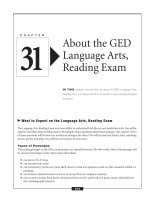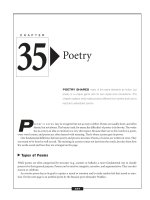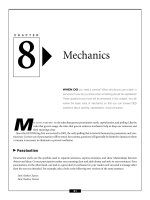The GED Language Arts, Reading Exam - Nonfiction
Bạn đang xem bản rút gọn của tài liệu. Xem và tải ngay bản đầy đủ của tài liệu tại đây (124.15 KB, 10 trang )
N
onfiction texts can be literary or functional. The literary nonfiction you might see on the
GED includes essays and autobiographies/memoirs. The functional texts you will see include
commentary on the arts and business communications.
How Nonfiction Is Different
While nonfiction texts may be imaginative, they differ from fiction because they are not about imagined people
and events. Rather, nonfiction texts deal with real people and real events.
There are other important differences between fiction and nonfiction as well. In nonfiction, there is no nar-
rator, so there is no “filter” between the author and the reader. In a nonfiction text, the author is speaking to the
reader directly, expressing his or her personal point of view. Thus, the voice in a nonfiction text is the unique voice
of the author.
Point of view is important in nonfiction. Remember, point of view establishes a certain relationship with the
reader. First-person texts are more personal but also more subjective. Third-person texts are more objective but
less personal. The point of view an author chooses will depend upon his or her purpose and audience. For exam-
ple, an annual report would likely use the third person, which is appropriate for a formal business document,
CHAPTER
Nonfiction
FROM ESSAYS to commentary to reports and memos, nonfiction
texts are written for many different purposes and have many different
functions. This chapter describes the kinds of nonfiction texts you will
see on the GED Language Arts Reading Exam.
37
337
while an essay about a personal experience would prob-
ably use the first-person point of view and explore the
impact of that experience on the writer.
Essays
There are many different types of essays. The four most
common types are:
1. descriptive: describing a person, place, or thing
2. narrative: telling a story or describing an event
3. expository: exploring and explaining an idea or
position
4. persuasive: arguing a specific point of view
There are essays about every imaginable topic, from
what it is like to grow up poor (or rich, or bilingual,
or ...) to why we should (or should not) clone human
beings. The basic structure of an essay is main idea→
support. Even if the writer is describing an experience, he
or she has a reason for telling that story, and that rea-
son—why the writer thinks the story is important
enough to tell—is the main idea.
Essays will often make their main idea clear in a the-
sis statement. This statement is likely to come at the
beginning of the essay. Notice how the author below
states his thesis at the end of the opening paragraph of
his essay:
When you think of former president Bill Clinton,
what’s the first thing that comes to mind? Unfor-
tunately, for many people, the first thing they
think of is Monica Lewinsky. Like millions of
people around the globe, I was horrified by how
much the Whitewater investigation delved into
Mr. Clinton’s private affairs. No one needed to
know the sort of details that were revealed by Ken
Starr’s investigation. But while I don’t want to
know the details, I do believe we have a right to
know what sort of lives our politicians are living. I
believe their behavior in private is a reflection of
their true values and how they will behave in office.
One type of writing that you may see in essays (as well
as other forms of literature) is satire. Satire is a form of
comedy in which the writer exposes and ridicules
someone or something in order to inspire change. Satires
rely heavily on verbal irony, in which the intended mean-
ing is the opposite of the expressed meaning. Satirists
also use hyperbole, which is extreme exaggeration, as well
as sarcasm and understatement in order to convey their
ideas.
Jonathan Swift’s 1729 essay “A Modest Proposal” is
one of the most famous examples of satire. In the essay,
Swift proposes that the Irish, who are starving, eat their
own children to prevent “the children of poor people in
Ireland from being a burden to their parents or country.”
Here’s a brief excerpt:
I have been assured by a very knowing American
of my acquaintance in London, that a young
healthy child well nursed is at a year old a most
delicious, nourishing, and wholesome food,
whether stewed, roasted, baked or boiled; and I
make no doubt that it will equally serve in a fric-
assee or ragout.
Of course, Swift is not really suggesting that the Irish
become cannibals. He is using this ridiculous proposal to
criticize the British for oppressing the Irish, especially
poor Irish Catholics, who often had many children. The
absurdity of Swift’s proposal reflects his feelings about
the absurdity of British rule in Ireland at the time and the
British government’s inability to find a satisfactory solu-
tion to the Irish famine.
Autobiography and Memoir
In an autobiography or memoir, the author will—very
subjectively, of course—tell the story of his or her life.
The difference between autobiographies and memoirs is
that memoirs tend to be less comprehensive and more
exploratory—they will cover less ground and spend
more time examining the impact of people and events
on their lives. Authors may write to clarify an experience,
teach a lesson, or make a statement about a historical
event or social movement. As you read an autobiography
or memoir, look for what the author feels has shaped
him or her. Why has he or she chosen to relate these par-
ticular events; describe these particular people?
On the next page is a brief excerpt from Frank
McCourt’s bestselling 1996 memoir, Angela’s Ashes.
–
NONFICTION
–
338
Next day we rode to the hospital in a carriage with
a horse. They put Oliver in a white box that came
with us in the carriage and we took him to the
graveyard. They put the white box into a hole in
the ground and covered it with earth. My mother
and Aunt Aggie cried, Grandma looked angry,
Dad, Uncle Pa Keating, and Uncle Pat Sheehan
looked sad but did not cry and I thought that if
you’re a man you can cry only when you have the
black stuff that is called the pint.
I did not like the jackdaws that perched on
trees and gravestones and I did not want to leave
Oliver with them. I threw a rock at a jackdaw that
waddled over toward Oliver’s grave. Dad said I
shouldn’t throw rocks at jackdaws, they might be
somebody’s soul. I didn’t know what a soul was
but I didn’t ask him because I didn’t care. Oliver
was dead and I hated jackdaws. I’d be a man
someday and I’d come back with a bag of rocks
and I’d leave the graveyard littered with dead
jackdaws.
Commentary on the Arts
The purpose of commentary is to illuminate or explain
other works of literature and art. These texts review and
analyze a work of art (performance art, visual art, and lit-
erature) and generally have two goals: to help us under-
stand the work of art and to evaluate its success or value.
A book review, for example, will typically offer some
background on the author, summarize the basic plot of
the story, and describe the main characters and their
chief conflicts. It will also point out what makes the novel
good (e.g., the characters are especially endearing, the
plot has surprising twists and turns, the descriptions are
particularly lush, the structure is very unique) or bad
(e.g., the plot is trite, the characters are flat and unbe-
lievable, the writing is clumsy, the chapters are disor-
ganized). Thus, commentary can help you determine
whether a work of art is something you should experi-
ence, and if you do experience it, the commentary can
help you make more sense of your experience.
The commentary on the GED can be of any sort,
including reviews of books, movies, concerts/musical
performances, dance productions, musicals, television
shows, plays, paintings, sculptures, photography, or
multimedia arts. But you are most likely to see com-
mentary on a visual art or experience.
When reading commentary, one of the most impor-
tant skills to have is the ability to distinguish between fact
and opinion. While commentators do deal with facts,
commentary is by nature highly subjective; they are shar-
ing their personal reactions to an experience with a work
of art. A good commentator will always explain why he
or she feels the way he or she does about a work of art.
For example, a movie critic might praise a film because
the story was original and moving, the actors convincing,
and the special effects stunning.
Remember, however, that the reviewer’s feelings
about the film are opinions, no matter how well the
author might defend them. There are many nondebat-
able facts about a work of art such as a film, including
when it was made, how long it took to make, who made
it, how much it cost, the events in the plot, how the spe-
cial effects were created, etc. But the reviewer’s judgment
of these facts is a matter of debate, and therefore a mat-
ter of opinion. You might find the story in a movie inter-
esting while your friend finds it boring.
As you read commentary, pay attention to word
choice. Even in sentences that seem to express facts, com-
mentators can express their opinion. For example, look
at the following sentences. They have the same meaning
but convey different attitudes:
Raquel Ramirez plays the role of Ophelia.
Raquel Ramirez shines in the role of Ophelia.
Business-Related Documents
Business documents were new to the GED as of 2002,
and you will see one on the Language Arts, Reading
Exam. These texts can range from employee handbooks
and training manuals to letters, memos, reports, and
proposals.
Business documents are unlike the other nonfiction
texts because they:
■
are meant for a specific audience
■
have a specific, business-related purpose
While essays, autobiographies, and commentary are
meant for a general reader, business documents (with the
exception of annual reports) are designed for a much
–
NONFICTION
–
339
smaller and more specific audience. Memos and letters,
for example, are often addressed to only one individual.
The purpose of each business document, too, is very
specific and related to business. A memo may provide an
agenda for a meeting or a reminder about forms that
need to be completed; a proposal may describe a plan to
improve or expand business; a training manual will show
employees how to perform specific tasks.
The purpose of the document will usually be made
very clear right from the start. As the saying goes, in busi-
ness, time is money, and in order to save the reader time,
writers of business communications state their purpose
clearly at the beginning of the document. For example,
notice how the main idea of the following letter is stated
in the second sentence:
Dear Ms. Ng:
Thank you for your recent application for an auto-
mobile loan from Crown Bank. Unfortunately, we are
unable to process your application because informa-
tion is missing from your application form.
We need the following information to complete the
loan application process:
1. the number of years in your current residence
2. your driver’s license number
3. the name and telephone number of your insur-
ance provider
Please provide this information to us as soon as pos-
sible. You may call me at 800-123-4567, extension 22,
or fax me at 222-123-4567. Please include application
code XT121 on your correspondence.
Thank you for your prompt attention to this matter.
I look forward to completing your loan application.
Sincerely,
Victor Wilson
Junior Loan Analyst
Crown Bank
Readability Techniques
To maximize time and clarity, business-related docu-
ments will use several readability techniques. These in-
clude chunking information and using headings and lists.
Business writers often organize information into
small, manageable “chunks” of data. That is, they will
group sentences or paragraphs according to the specific
topics or ideas they discuss and set those sentences apart
with line breaks and/or headings.
Headings and subheadings provide “titles” within the
text to guide readers topic by topic through the docu-
ment. Headings show readers how ideas are related and
help readers find specific information in the document.
(Notice, for example, how headings are used throughout
this book.)
To make information easier to process, business writ-
ers will also use bulleted or numbered lists as often as
possible, especially when providing instructions. It is eas-
ier to see the items in a list when they are separated and
listed vertically rather than running together horizon-
tally in a regular sentence or paragraph. For example,
notice how much easier it is to absorb the information in
the bulleted list than in the following narrative:
To apply for a permit, you must bring proof of
residency, a photo identification, a copy of your
birth certificate, and proof of insurance.
To apply for a permit, you must bring:
■
proof of residency
■
a photo identification
■
a copy of your birth certificate
■
proof of insurance
Whether the text is a business document or a personal
essay, remember that writers always write for a reason.
Think about the writer’s purpose. Why is he or she writ-
ing? Look for clues in both content (including specific
facts and details) and style (including word choice and
tone). Check for topic sentences and thesis statements
that express the author’s main idea.
–
NONFICTION
–
340
I
n this chapter, you will review the structure of the reading exam and specific tips you can use to
improve your score on the test. Read this chapter carefully, and then review your notes from the whole Lan-
guage Arts, Reading section. When you are ready, move on to the practice questions that follow.
The GED Language Arts, Reading Test in a Nutshell
This GED exam consists of 40 multiple-choice questions about texts from three different time periods: pre-1920,
1920–1960, and 1960–present. Each exam will include a poem, an excerpt from a play, a commentary on the arts,
a business-related document such as a memo or report, and at least one excerpt from a work of fiction. Each pas-
sage (except the poem) will be approximately 200–400 words long.
Questions will test your basic comprehension of the texts (20%), your ability to analyze the texts (30–35%),
your ability to “synthesize” (draw inferences from) ideas from the texts (30–35%), and your ability to apply infor-
mation or ideas from the texts to different contexts (15%). You may be asked about the main idea or theme of a
text, a character’s feelings or motivations, or the significance of a symbol. You may be asked to identify a specific
fact or detail or to predict the effect of an action described or implied in the text. You might be asked about the
effect of a rhetorical technique or to identify the tone of a passage.
CHAPTER
Tips and
Strategies for the
Language Arts,
Reading Exam
YOU HAVE reviewed a lot of material to prepare for the GED Lan-
guage Arts, Reading Test. Now here are some specific tips and strate-
gies for handling the questions you will see on the exam.
38
341









